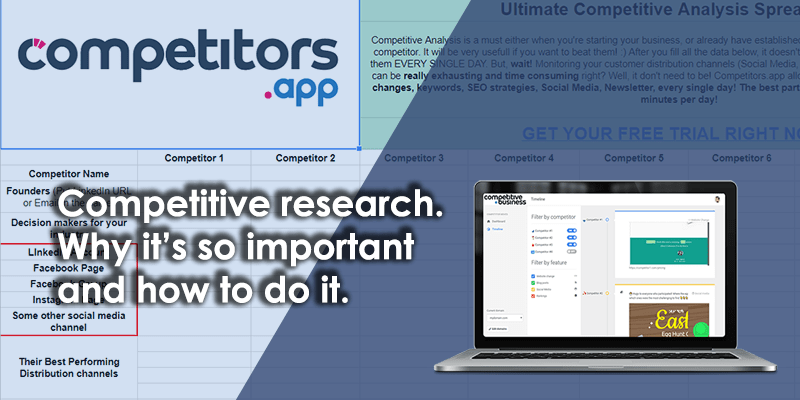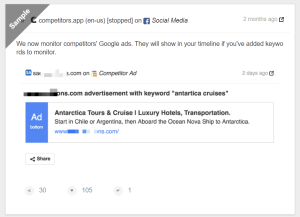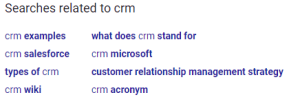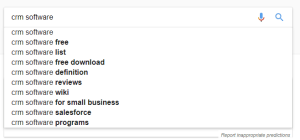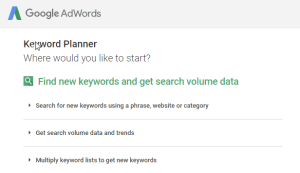
5 Best ways to create a killer competitive advantage
All of us have something in common – we have competitors. And sometimes, how will we beat them and create a competitive advantage is our biggest concern.
I talked with several professionals and experienced CEOs and CMOs in their industries. All of them shared their valuable insights about how they created a competitive advantage and scaled their business among many competitors.
Together with our experience, this article represents an ultimate guide on competitive advantages – what are and how to use them to beat your competition.
First things first – How to do your competitive research.
Before you even think about creating competitive advantages, it’s time to do your competitive research.
Competitive research is a must, and there are various ways how to do it efficiently. Because this isn’t the main topic of this article, we will cover the most critical steps.
Whether you are starting a new business or already have established one, some new direct or indirect competitor is born every second day. So competitive research is a renewable process; you should do it at least every second week.
The best way to find new competitors is to try keywords research.
Look for the following information about your competitors:
- Founders – It’s essential to know who your competitor decision-makers are
- Social Media Networks URLs – How are they, for God’s sake, communicating with their customers? What content are they creating?
- Distribution channels – How are they finding new customers?
- Core Value propositions – What are the main differences between them and you? What are their Core Value propositions, and how my product/service can be more useful to my customers than theirs?
- The number of employees, headquarters, stage, and the size of the investment – This helps you to understand how big their resources are, and you can imagine what they are capable of.
- Other information (Number of customers, website visitors, etc.)
Here’s a list of websites that can be quite useful for you and it can save you a lot of time:
For this, you can use our Ultimate Competitor Analysis spreadsheet to ensure you didn’t miss any information about your competitors (By the way, it will save you a lot of time and make organization easy).
Our friend, Ognjen Vuković from Reportz, explained in a few sentences why competitive analysis is so vital for your business:
“Knowing your competition is good. Knowing what works for them is even better, and knowing how to do that better than them is the ultimate goal you should set regarding your competitor analysis.
In Reportz, we use multiple tools and techniques to monitor and outperform particular clients’ competitor activities, such as social behavior, paid efforts metrics, and SEO/SEM stats.
Every good strategy has to have competitor analysis at its core since having in-depth info about what works best for your competitors can give you an overview of what to focus on and how to outperform them to make a success.”
What is a competitive advantage?
Without good competitive advantages, we will never get our market share. So it’s really important to understand what competitive advantage is.
Let’s understand it with the example:
We have two companies specializing in “connecting people in the world.”
The first company is older and already has a relatively big customer base. The second one is new but promising and more attractive.
The second company had more features and was entertaining, while the first company wasn’t.
They empowered people to connect and to make relationships.
Later, the second company got funding and monopolized the market.
You probably know which companies I’m talking about – they are MySpace and Facebook.
So, a competitive advantage is anything that can help you to outmaneuver your competition. It can be price, unique value proposition, better product, better communication, or better marketing and sales.
In the case of Facebook – It was a better story. A story that empowered people to take action.
Storytelling – the art of making your customers special
Today people do not follow brands and logos. They are the following stories.
They identify themselves with the stories of other brands.
Coca-Cola is a great example: Its competitive advantage is based on empowering people to take actions with various marketing campaigns that are alluding to happiness, love, relationship, and friendship.
Nike is another great example of perfect storytelling (Especially with their campaign with Colin Kaepernick).
Beverley Theresa, CEO of Social Media with Beverley Theresa, told us her story and how she created her competitive advantage with content and personal branding:
“Content is key. I’m consistently creating and offering free valuable learning for people looking to set up their social media. It helped me to grow my business immensely.
Also, my background helped me to build credibility. So people told me that my attitude and personal brand give me a competitive advantage. They are usually contacting me and saying that they want to work with me because of the way how I’m communicating.”
Don’t be afraid to tell stories. Explain to your potential customers what drives you and why you are doing what you are doing. What’s your idea, mission, and vision?
Research your target audience and find out what are their main problems and create engaging content with a lot of useful information and resources based on your potential customer’s problems.
But remember this – content isn’t only the blog post – it’s much more. You can engage with your potential customers in various ways:
- Create funny videos with explanations and solutions to your potential customers’ problems
- Create Infographics
- Make Quizzes, How To’s, Guides, Playbooks, Workbooks, and Spreadsheets
One thing matters more than the content itself – its distribution.
Here is some advice on how you can distribute your content very well:
- Prepare your content in different formats – Instagram posts, Instagram stories, Facebook posts, etc.
- Distribute your content on Guest blog posts, your blog, Quora, Medium, Reedit, etc.
- Post in different Facebook Groups
- Ask Influencers to share
- Motivate your customers to share it by giving some offer or other free resources (spreadsheet, for example)
Prepare your content based on your potential customers’ needs – make them feel special! 🙂
Focus on your users
Good business is based on two things:
- Good team
- The loyal and engaging user base
Sometimes everything which matters is creating a good relationship with your users.
Baptiste Debever from Feedier explained to us how they managed to create competitive advantages in an industry full of competition – both direct and indirect:
“Any feedback tool is a competitor of Feedier. But that’s okay. Feedback is a huge market, and the so-called surveys are just a part of it.
We want to create our crusade focusing on feedback, and the user is what matters the most. So gamification, experience, and rewards are what’s important to create competitive advantages in the overcrowded industry.
– Feedier is built from scratch to engage your customers. Our technology knows whether the customer is happy or not, and therefore, we can provide the right engagement to the right user. Asking for 5-star reviews only to customers being at least 80% satisfied, for example.
– Feedier adapts the questions to the customer. Thanks to the first step, we know whether the customer is happy or not and why. We can, therefore, adopt the question to any customer based on that. The experience is unique!
– Feedier aims to create a relationship between your team, customers, and products.
– it makes it easy for you to share your surveys with the right customers. We will send the emails for you, write your social posts and even let you embed them right into your website.
– And finally, Feedier is gamified with a complete framework and the ability to send rewards at the end of the survey.”
Anita Erker from Linkchain shared with us their way to create a competitive advantage by focusing on her users:
“Listening, listening, and listening. Value creation is a constant, ongoing art.
Each day I conduct a micro-research, which helps me to gather more in-depth details – not just about the competition, but users, the marketplace, partners,… Each segment of the audience is equally important. To keep the balance and differentiate yourself is in the middle of that matrix.”
From their practices, we can find out that building a loyal customer base and good user experiences helps you to create proper competitive advantages.
Find the niche where you can make a difference.
Sometimes it is not easy to compete with big companies and dinosaurs. With much effort and money invested in getting low results, it can be hard.
Sometimes, the best solution is to be specialized in one-two unique thing.
The best example of this is Trello. Trello created an industry monopoly over the much bigger competitor – Astana – by focusing only on one thing.
Nemanja Zivkovic from Default Design described to us how they are creating competitive advantages by delivering results and focusing on a unique niche:
“We’re focused on giving a constant value, daily, on one side. We’re present in communities everywhere where our customers are.
Conversely, we focus on delivering results in conversions and leads.
When our customer is making profit, he has enough to pay us, and everybody’s happy.
On the other hand, we’re organizing the 1st online conference in the ExYu countries focused on conversions and marketing automation while creating a platform for marketing automation and pioneering website personalization.
We found a niche within marketing where we can make a difference.”
Kady Hobbins from Kaden Ave Communications is another great example of how to create competitive advantages with delivering the best results:
“We’ve set ourselves apart by really drilling down and specializing in what we’re truly good at – making high-quality social media content that helps generate conversions and build brand awareness. We try not to spread ourselves thin and do things we’re just okay at, nor do we take on clients we don’t think are the right fit. In return, we’re happier, and our clients are happier.”
Build a respected brand and community.
Sometimes, building a good brand is everything you need. But this process is long and hard.
Building a good brand is easiest to do with building communities.
Communities are one of the greatest things humanity ever invented! Building a community allows us to share more value and knowledge with our potential customers.
If you don’t want or don’t have time to build your community, sometimes it is enough to actively participate in the existing one.
Ioana Budai from Apart25 shared with us their secret to creating competitive advantages by actively contributing to communities and networking events:
“We’re standing by a ‘Go the extra mile’ approach, so we always aim to offer some extra insights besides our main service lines. Apart from this, we also get involved in the community and create networking spaces for people in our industry and the local startup environment.
In short, this is what makes us great at better grasping the needs of our clients and partners.”
Solve Big Problems
Sometimes solving problems with significant pain is everything that you need.
If your potential customers discover about your product benefits, which provide them value, they will buy it.
Vlad Calus from Planable shared with us how they managed to create a relatively new market and solve the actual problems:
“As a team, we worked a lot in the past with brands and agencies and struggled ourselves with the issues of content, collaboration, and approvals. We started from the premise that we wanted to build a product that essentially solves their problem from the group up. That’s what resulted in Planable becoming the most visual content collaboration platform, which is our biggest advantage.”
Creating competitive advantages isn’t easy, but creating a monopoly in some industries is necessary.
Maintaining an eye on your competition helps you create a competitive advantage and be better than them. That’s the reason why we always need to monitor their:
- Social Media
- SEO and PPC campaigns
- Newsletters
- Website changes and keywords
Competition never sleeps, that’s the reason why you shouldn’t too.
Claim your 15-day free trial of Competitors App, and be one step ahead of your competition even today!



